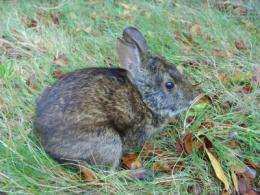Working to conserve endangered 'Playboy' bunnies

Playboy founder Hugh Hefner's legacy will live on with a new University of Central Florida study aimed at saving the endangered bunnies named after him.
Rosanna Tursi, a master's student and graduate teaching assistant, is using population genetics to aid in the conservation of the Lower Keys marsh rabbits (Sylvilagus palustris hefneri), which were declared endangered in 1990. It is estimated that less than 300 rabbits remain today.
Hefneri, the most recently recognized subspecies of the marsh rabbit, is small with short, dark brown fur and a grayish-white belly. Discovered in 1984, the subspecies was named in honor of Hefner after his organization donated money to support fieldwork on the rabbits.
Hefneri live in an island environment and are dependent on specific grasses and plants for feeding, nesting and shelter. Population growth and development in the Lower Keys has led to the death of the bunnies at the hands of vehicles or domestic animals. Their natural habitat also is being destroyed.
According to Tursi, the ability of a species to adapt to new conditions depends on the variety of genetic information present in natural populations. The more genetic diversity a species has, the greater its rate of survival is.
"The loss of genetic diversity can have long-term repercussions by affecting the evolutionary potential of the species," Tursi said.
UCF Assistant Professor Eric Hoffman and Philip Hughes, an endangered species biologist with the U.S. Fish and Wildlife Service (USFWS) in Big Pine Key, landed a grant to study the bunnies. Tursi joined the team and is conducting fieldwork this summer in the Everglades and Florida Keys. The USFWS is interested in Tursi's finding because it wants to prevent the bunnies' from becoming extinct.
The USFWS hopes to identify rabbits from the most genetically diverse populations, relocate them and create a new population in a habitat where the bunnies are less likely to be disturbed.
The project was a perfect thesis subject for Tursi, who earned a degree in Molecular Biology, Microbiology and Biotechnology from Florida Atlantic University before enrolling at UCF.
"Nature and conservation of wildlife have always been my passion, and I wanted to use my molecular and genetic knowledge to help endangered species," Tursi said.
Hoffman said Tursi's work could certainly help keep the species viable.
"Our hope is to both characterize the amount of diversity in the Keys populations and determine which rabbit populations would provide the best rabbits to found new translocated populations set up by the USFWS," Hoffman said.
Tursi is currently working with another marsh rabbit subspecies, Sylvilagus palustris paludicola, which is native to South Florida and the Everglades. She is using hair follicles gathered from mainland rabbits to extract DNA. Once sample collection is finished, Tursi will conduct DNA analysis and compare the diversities of the paludicola and hefneri over the next four or fives months.
Tursi hopes her work will serve as "a model for future conservation and reintroduction efforts."
According to the Florida Fish and Wildlife Conservation Commission, there are 41 endangered species in Florida. Species become endangered after they experience a significant vulnerability to habitat modification, environmental alteration or human disturbance, which results in the existence of the species becoming threatened unless appropriate protective or management techniques are used. UCF has several research projects underway to help conserve at least nine endangered species.
Source: University of Central Florida (news : web)
















